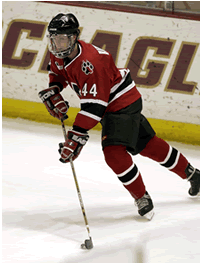February
19, 2004
Coaches
Ask NCAA to Revisit Opt-In Rule
By
Mike Eidelbes
Inside College Hockey.com Exclusive
A group of
college coaches has presented the NCAA with information in the
hopes that it will revisit its position on the opt-in rule, Inside
College Hockey has learned.
The rule,
enacted in 1995, requires prospects born between Sept. 16, 1985,
and Sept. 15, 1986 to declare their intentions by May 1 in order
to enter the pool for the upcoming National Hockey League Entry
Draft. College players who opt in forfeit the remainder of their
eligibility.
“What
we’re explaining [to the NCAA] is that these kids want to
stay in school,” said Notre Dame coach Dave Poulin, who
spearheaded the effort. “It’s about the ability to
choose.”
 |
| Northeastern's
Steve Birnstill is one of 12 college players who could opt
in to the 2004 NHL Draft. |
Poulin –
who has an opt-in prospect on his roster in defenseman Wes O'Neill
– and other college coaches with players who can declare
their eligibility for the 2004 draft wrote letters to NCAA Director
of Agent, Gambling and Amateurism Bill Saum stating their position
on the opt-in rule. Those letters were delivered to the organization’s
headquarters in Indianapolis earlier this week.
The interpretation
of the opt-in rule added a new wrinkle last year, when the NCAA
ruled that junior players could opt in and retain their college
eligibility as long as they hadn't enrolled in school yet. Meanwhile,
players of the same age who are already in college would have
to forfeit their eligibility to opt in.
“It’s
a tough choice for all these players, and it’s one they
shouldn’t have to make,” said Boston College’s
Jerry York, who coaches an opt-in candidate in freshman forward
Adam Pineault. “If Adam had played at the national program
for another year, he could get drafted and still be in school
next year. Now he’s going to have a tough decision to make.”
According
to Poulin, who met with Saum recently, the opt-in rule can be
modified on a short-term basis by an NCAA Management Council sub-committee.
Any long-term change to the policy would have to proceed though
the NCAA’s standard legislative path.
“It’s
not a controversial situation at all,” Poulin said. “[The
NCAA is] very understanding of it.”
There are
12 college players who could opt in to the 2004 NHL Draft, including
the top four collegiate prospects in the Central Scouting Services
Mid-Term Rankings – North Dakota's Drew Stafford, Michigan
State's A.J. Thelen, O'Neill and Pineault.
The only player
to forgo his remaining college eligibility by opting in to the
NHL Draft is former Boston University goaltender Rick DiPietro,
who left the Terriers after his freshman season and was selected
by the New York Islanders with the first overall pick in 2000.
Proponents of amending the opt-in rule point to DiPietro’s
struggle for consistency in the professional ranks to support
their position.
“When
Ricky DiPietro had to make that choice, I thought it was really
unfortunate,” York said. “It was unfortunate for him,
and probably for the Islanders, too – they probably would
have liked to have had him back at school for another year.”
| 2004
NCAA Opt-In Candidates |
| Player |
Team |
Pos. |
| Sean
Bentovoglio |
Niagara |
F |
| Steve
Birnstill |
Northeastern |
D |
| Jeff
Caron |
Merrimack |
D |
| Matt
Cohen |
Yale |
D |
| Steve
Hartley |
Miami |
G |
| T.J.
Hensick |
Michigan |
F |
| Wes O'Neill |
Notre
Dame |
D |
| Adam
Pineault |
Boston
College |
F |
| Jonathan
Sigalet |
Bowling
Green |
D |
| Drew
Stafford |
North
Dakota |
F |
| Paul
Szczechera |
Western
Michigan |
F |
| A.J.
Thelen |
Michigan
State |
D |
As college
coaches continue to spot more potential recruits at earlier ages,
the possible effects of the rule will grow at a similar rate.
Michigan goaltender Al Montoya could’ve opted into the 2003
NHL Entry Draft and likely would’ve been chosen in the first
round. He chose to stay in Ann Arbor, however, and is a lock to
be taken in the opening round of this year’s draft.
“Kids
are being recruited when they’re 14 years old,” Montoya
said. “A player that accelerates and is ready for the next
level at an early age should have the option to go into the draft.”
Modifying
the opt-in rule helps NHL clubs in two ways. One, it would allow
young prospects to improve and mature in the college environment
where they can play against players who are up to seven years
older, spend more time sharpening skills in practice and take
part in strength and conditioning programs. Second – and
perhaps most important – letting younger players find their
games in college is far more cost effective than drafting a prospect
and watching him struggle in the professional ranks.
“I’ve
never had a drafted player leave early,” Poulin said. “If
[the team that drafted them] is pleased with the way a player
is developing, they’re apt to leave him there.”
Poulin
says he expects a ruling on the matter as soon as next week.
Additional reporting by Nate Ewell.